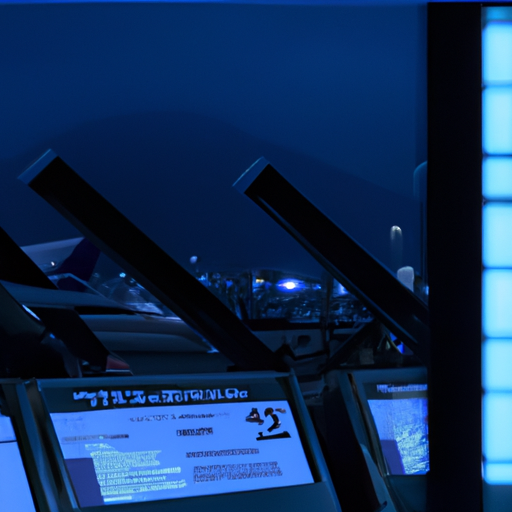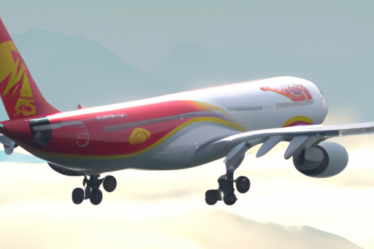
Impressive Growth: Hong Kong Airport Reports Record Cargo and Passenger Numbers in August
Hong Kong Airport has recently reported its cargo and passenger numbers for the month of August, and the results are nothing short of impressive. The airport has experienced record-breaking growth in both categories, solidifying its position as one of the busiest and most important transportation hubs in the world.
In terms of cargo, Hong Kong Airport handled a staggering 450,000 metric tonnes in August alone. This represents a significant increase of 8.2% compared to the same period last year. The growth can be attributed to a variety of factors, including increased demand for e-commerce and the ongoing recovery of global trade. The airport’s strategic location in the heart of Asia also plays a crucial role in its success, as it serves as a major gateway for goods traveling between East and West.
Passenger numbers at Hong Kong Airport have also reached new heights, with over 6 million travelers passing through its gates in August. This marks a remarkable 11.5% increase compared to the previous year. The airport’s extensive network of airlines, offering connections to over 220 destinations worldwide, has undoubtedly contributed to this growth. Additionally, Hong Kong’s status as a popular tourist destination and a major business hub has attracted a steady stream of visitors from all corners of the globe.
The impressive growth in cargo and passenger numbers is a testament to the airport’s commitment to providing top-notch services and facilities. Hong Kong Airport has consistently invested in infrastructure improvements and technological advancements to ensure a seamless travel experience for its customers. From state-of-the-art terminals to efficient baggage handling systems, the airport has spared no effort in creating a world-class facility that meets the needs of both passengers and cargo operators.
Furthermore, Hong Kong Airport has implemented various initiatives to enhance its sustainability and reduce its environmental impact. The airport has been actively promoting the use of electric ground vehicles and has installed solar panels to generate clean energy. These efforts align with the global push for greener transportation solutions and demonstrate the airport’s dedication to being an environmentally responsible organization.
Looking ahead, Hong Kong Airport is poised for continued growth and success. The airport’s ongoing expansion plans, including the construction of a third runway, will further increase its capacity and enable it to handle even larger volumes of cargo and passengers. Additionally, the airport is constantly exploring new opportunities to attract more airlines and expand its route network, ensuring that it remains a vital link in the global aviation industry.
In conclusion, Hong Kong Airport’s record-breaking cargo and passenger numbers in August highlight its position as a leading global transportation hub. The airport’s strategic location, extensive network, and commitment to excellence have contributed to its impressive growth. With ongoing investments in infrastructure and sustainability, Hong Kong Airport is well-positioned to continue its upward trajectory and meet the evolving needs of the aviation industry.
Key Factors Behind Hong Kong Airport’s August Success: Analyzing Cargo and Passenger Trends

Hong Kong Airport has recently reported its cargo and passenger numbers for the month of August, and the results are impressive. The airport has seen a significant increase in both cargo and passenger traffic, which is a positive sign for the region’s economy. In this article, we will analyze the key factors behind Hong Kong Airport’s success in August, focusing on the trends in cargo and passenger numbers.
Let’s start by looking at the cargo trends. Hong Kong Airport has always been a major hub for air cargo, and August was no exception. The airport reported a 9.1% increase in cargo throughput compared to the same period last year. This growth can be attributed to several factors.
Firstly, the global demand for electronic products has been on the rise, and Hong Kong is a major exporter of these goods. With the increasing popularity of smartphones, tablets, and other electronic devices, there has been a surge in the shipment of these products. Hong Kong Airport has played a crucial role in facilitating the transportation of these goods to various destinations around the world.
Secondly, the ongoing trade tensions between the United States and China have also contributed to the increase in cargo traffic. As companies try to avoid potential tariffs, they have been shifting their production and sourcing to other countries in the region. Hong Kong, with its well-established logistics network, has become a preferred choice for many businesses looking to reroute their supply chains. This has resulted in a higher volume of cargo passing through the airport.
Now let’s turn our attention to the passenger trends. Hong Kong Airport has experienced a steady growth in passenger numbers, with August being no different. The airport recorded a 2.8% increase in passenger traffic compared to the same period last year. This growth can be attributed to a few key factors.
Firstly, Hong Kong has become an increasingly popular tourist destination in recent years. The city’s vibrant culture, stunning skyline, and world-class attractions have attracted visitors from all over the globe. As a result, more and more tourists are choosing to fly into Hong Kong, boosting the airport’s passenger numbers.
Secondly, Hong Kong’s strategic location makes it a convenient transit hub for travelers. Many international flights pass through Hong Kong on their way to other destinations in Asia and beyond. This has led to an increase in transit passengers, who choose to spend a few days exploring the city before continuing their journey. The airport’s excellent facilities and efficient transit services have made it a preferred choice for these travelers.
In conclusion, Hong Kong Airport’s success in August can be attributed to several key factors. The increase in cargo throughput can be attributed to the growing demand for electronic products and the ongoing trade tensions between the United States and China. On the other hand, the growth in passenger numbers can be attributed to Hong Kong’s popularity as a tourist destination and its strategic location as a transit hub. With these trends in mind, it is clear that Hong Kong Airport is well-positioned to continue its growth and contribute to the region’s economy.
Hong Kong Airport’s August Performance: A Closer Look at the Impact on the Aviation Industry
Hong Kong Airport, one of the busiest airports in the world, recently released its cargo and passenger numbers for the month of August. These figures provide valuable insights into the current state of the aviation industry and shed light on the impact of various factors on air travel.
In terms of cargo, Hong Kong Airport reported a slight decrease compared to the same period last year. The total cargo throughput for August stood at 382,000 metric tons, representing a 1.5% decline year-on-year. This decline can be attributed to several factors, including the ongoing trade tensions between the United States and China, which have resulted in reduced demand for air freight.
However, it is worth noting that despite the overall decrease, certain segments of the cargo market performed well. Transshipments, for example, saw a significant increase of 9% compared to August 2018. This suggests that Hong Kong Airport continues to serve as a major hub for connecting flights and facilitating global trade.
On the passenger front, Hong Kong Airport experienced a more significant decline in August. The total number of passengers handled during the month was 6 million, representing a 12.4% decrease compared to the same period last year. This decline can be attributed to a combination of factors, including the ongoing protests in Hong Kong and the resulting travel advisories issued by various countries.
Despite the decline in passenger numbers, Hong Kong Airport remains optimistic about the future. The airport’s management has been actively working to restore confidence in air travel to and through Hong Kong. They have implemented various measures to ensure the safety and security of passengers, as well as to minimize disruptions caused by the protests.
Furthermore, Hong Kong Airport has been actively engaging with airlines and travel agencies to promote the city as a desirable destination. They have launched promotional campaigns and offered incentives to attract tourists and business travelers. These efforts are aimed at boosting passenger numbers and revitalizing the aviation industry in Hong Kong.
Looking ahead, the aviation industry in Hong Kong faces both challenges and opportunities. The ongoing trade tensions and protests continue to pose risks to air travel, but there are also signs of resilience and potential for growth. As the situation in Hong Kong stabilizes and confidence in air travel is restored, it is expected that passenger numbers will gradually recover.
In conclusion, Hong Kong Airport’s cargo and passenger numbers for August provide valuable insights into the current state of the aviation industry. While there has been a decline in both cargo and passenger numbers, certain segments of the market have performed well, and efforts are being made to restore confidence in air travel. With proactive measures and a focus on promoting Hong Kong as a desirable destination, the aviation industry in the city has the potential to bounce back and thrive in the future.


